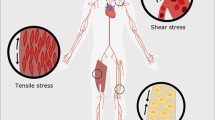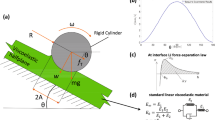Summary
The cell-substratum adhesive characteristics of cultured chick embryo primary mesoderm cells have been examined by inteference reflection microscopy and transmission electron microscoy under various conditions. Correlations were drawn between the type of adhesion and the degree of motility shown by the cells. During the rapid spreading and motility of cells cultured on fibronectin-containing substrate, focal contacts (10 to 15-nm gap) were rare and close contacts (about 30-nm gap) were pedominant. By contrast, when the cells were immobile, after 5 d in cultue, extensive focal contacts were present, together with stress fibers. The results indicate that tight cell-substratum contact is incompatible with rapid cell motility and that fibronectin acts by inducing the formation of close contacts rather than focal contacts.
Similar content being viewed by others
References
Abercrombie, M.; Heaysman, J. E. M.; Pegrum, S. M. The locomotion of fibroblasts in culture. IV. Electron microscopy of the leading lamella. Exp. Cell Res. 67: 359–367; 1971.
Al-Nassar, N. A. E.; Bellairs, R. An electron-microscopical analysis of embryonic chick tissues explanted in culture. Cell Tissue Res. 225: 415–426; 1982.
Barer, R.; Joseph, S. Refractometry of living cells. Part I. The basic principles. Q. J. Microsc. Sci. 95: 399–423; 1954.
Couchman, J. R.; Rees, D. A. The behaviour of fibroblastic migrating from chick heart explants: Changes in adhesion, locomotin and growth, and in the distribution of actomyosin and fibronectin. J. Cell Sci. 39: 149–165; 1979.
Curtis, A. S. G. The mechanism of cell adhesion to glass. A study by intereference—refection microscopy. J. Cell Biol. 20: 199–215; 1964.
Fox, C. H.; Cottler-Fox, M. H.; Yamada, K. M. The distribution of fibronectin in attachment sites of chick fibroblasts. Exp. Cell Res. 130: 477–481; 1980.
Gail, M. H.; Boon, C. W. Cell substratum adhesivity. A determinant of cell motility. Exp. Cell Res. 70: 33–40; 1972.
Gingell, D. The interpretation of interference—reflection images of spread cells: significant contributions from thin peripheral cytoplasma. J. Cell Sci. 49: 237–247; 1981.
Hamburger, V.; Hamilton, H. L. A series of normal stages in development of the chick embryo. J. Morphol. 88: 49–92; 1951.
Heasysman, J. E. M.; Pegrum, S. M.; Presto, T. M. Spreading chick heart fibroblasts. A correlated study using phase contrast microscopy. RIM, TEM and SEM. Exp. Cell Res. 140: 85–93; 1982.
Hynes, R. O.; Destree, A. T.; Wagner, D. D. Relationships between microfilaments, cell-substratum adhesion and fibronectin. Cold Spring Harbor Symp. Quant. Biol. 46: 659–670; 1982.
Ireland, G. W.; Stern, C. D. Cell-substrate contacts in cultured chick embryonic cells: an interference reflection study. J. Cell Sci. 58: 165–183; 1982.
Ireland, G. W.; Voon, F. C. T. Polygonal networks in living chick embryonic cells. J. Cell Sci. 52: 55–69; 1981.
Izzard, C. S.; Lochner, L. R. Cell-to-substrate contacts in living fibroblasts: an interference—contacts in living fibroblasts: an evaluation of the technique. J. cell Sci. 21: 129–159; 1976.
Izzard, C. S.; Lochner, L. R. Formation of cell-to-substrate contacts during fibroblast motility: an interference—reflextion study. J. Cell Sci. 42: 81–116; 1980.
Keller, H. U.; Barundun, S.; Kistler, P.; Ploem, J. S. Locomotion and adhesion of neutrophil granulocytes. Effects of albumin, fibrinogen and gamma globulins studied by reflection contrast microscopy. Exp. Cell Res. 122: 351–362; 1979.
King, C. A.; Preston, M.; Miller, R. H.; Grosse, C. The cell surface in amoeboid locomotion—studies Cell Biol. Int. 6: 893–900; 1982.
Kolega, J.; Shure, M. S.; Chen, W-T.; Young, N. D. Rapid cellular translocation is related to close contacts formed between cultured cells and their substrata. J. Cell Sci. 54: 23–34; 1982.
Lewis, L.; Verna, J-M.; Levinstone, D.; Sher, S.; Marek, L.; Bell, E. The relationship of fibroblast translocations to cell morphology and stres fibre density. J. Cell Sci. 53: 21–36; 1982.
Norton, E. K.; Izzard, C. S. Fibronectin promotes formation of the close cell-to-substratum contact in cultured cells. Exp. Cell Res. 139: 463–467; 1982.
Rees, D. A.; Couchman, J. R.; Smith, C. G.; Woods, A.; Wilson, G. Cell-substratum interactions in the adhesion and locomotion of fibroblasts. Philos. Trans. R. Soc. Lond. [Biol.] 299: 169–176; 1982.
Sanders, E. J.; Bellairs, R.; Portch, P. A.In vivo andin vitro studies on the hypoblast and definitive endoblast of avian embryos. J. Embryol. Exp. Morphol. 46: 187–205; 1978.
Sanders, E. J. Inability of mesodern cells to locomote on the modified free surface of epithelial cell sheets in vitro. In Vitro 18: 71–78; 1982.
Sanders, E. J. Recent progress towards understanding the roles of the basement membrane in development. Can. J. Biochem. Cell Biol. 61: 949–956; 1983.
Sanders, E. J. The effect of fibronectin and substratum-attached material on the spreading of chick embryo mesoderm cellsin vitro. J. Cell Sci. 44: 225–242; 1982.
Sanders, E. J. Ultrastructural immunocytochemical localization of fibronectin in the early chick embryo. J. Embryol. Exp. Morphol. 71: 155–170; 1982.
Singer, I. I. Fibronexus formation is an early event during fibronectin-induced restoration of more normal morpholog and substrate adhesion patterns in transformed hamster fibroblasts. J. Cell Sci. 56: 1–20; 1982.
Virtanen, I.; Vartio, T.; Badley, R. A.; Lehto, V-P. Fibronectin in adhesion, spreading and cytoskeletal organization of cultured fibroblasts. Nature 298: 660–663; 1982.
Yates, J. R.; Izzard, C. S. Cell-to-substrate contacts in an adhesion-defective mutant of BALB/c3T3 cells. J. Cell Sci. 52: 183–196; 1981.
Author information
Authors and Affiliations
Additional information
This work was supported by grants from the Medical Research Council of Canada and the Alberta Heritage Foundation for Medical Research.
Rights and permissions
About this article
Cite this article
Sanders, E.J. Substratum attachment of embryonic mesoderm cells in culture. In Vitro 20, 521–527 (1984). https://doi.org/10.1007/BF02639767
Received:
Accepted:
Issue Date:
DOI: https://doi.org/10.1007/BF02639767




